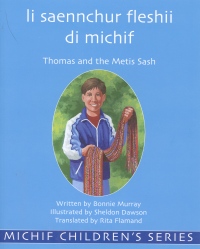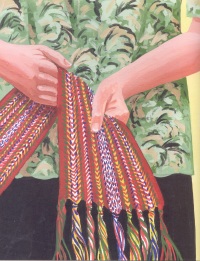| ________________
CM . . .
. Volume XI Number 18 . . . .May 13, 2005
excerpt:
According to some sources, Michif, traditionally an oral language, has fewer than 1000 people who still speak it today, and most of them are located on the Prairies. Michif, the language of the Metis people, began as a trade language some three centuries ago and largely combines Cree and Canadian French with some borrowing from English and other First Nations languages like Ojibwe. The books in the "Michif Children's Series" are one attempt to keep the language alive by presenting it to pre- and early schoolers in a written form. Li Saennchur Fleshii di Michif or Thomas and the Metis Sash is the third collaboration among this trio of author, illustrator and translator. In each book, Thomas is introduced to another aspect of his Metis cultural heritage. In Li Minoush, Thomas learned about the Michif language while, in Li Paviyon de Michif, Thomas, having to bring something to school to represent his culture, chose the white and blue flag of the Metis nation. In the present offering, Thomas and his classmates finger weave a two colour belt in art class. When Thomas takes his blue and white belt home to show his parents, his mother says it reminds her of her Metis Sash which she takes out to show Thomas. She briefly explains the sash's uses before going on to describe the significance of its pattern and colours. Thomas then asks to take the sash to school where he shares the sash and his mother's explanation with his classmates and art teacher.
Because the principal purpose of Thomas and the Metis Sash is to share an aspect of Metis cultural life, the plot in this slim volume, with its parallel text both in English and Michif, is really quite minimal. However, one of the book's very positive features is that author Murray has Thomas take his mother's sash to school for sharing, a reminder that those who are not part of the Metis culture also need to have their awareness levels raised. Recommended. Dave Jenkinson teaches courses in children's and adolescent literature in the Faculty of Education, the University of Manitoba.
To comment
on this title or this review, send mail to cm@umanitoba.ca.
Copyright © the Manitoba Library Association. Reproduction for personal
use is permitted only if this copyright notice is maintained. Any
other reproduction is prohibited without permission.
NEXT REVIEW |
TABLE OF CONTENTS FOR THIS ISSUE
- May 13, 2005.
AUTHORS |
TITLES |
MEDIA REVIEWS |
PROFILES |
BACK ISSUES |
SEARCH |
CMARCHIVE |
HOME |

 In each pair of facing pages in Thomas and the Metis Sash, one full page consists of a Dawson painting while the other page contains the English text at the top and the Michif text at the bottom. The two texts are separated by a smaller illustration which is usually a detail from the larger illustration. Sharp-eyed youngsters will detect a difference between Murray's text and Dawson's illustration. When Thomas's mother explains the significance of her sash's colors, she speaks about red, blue, white, green and black (the colors adopted by the Manitoba Metis Federation for a unique Metis Sash). However, the sash Dawson portrays in his illustrations obviously contains a lot of "unexplained" yellow. The black that Thomas's mother talks about can, at best, be seen in only one of the sash's fringed ends. On another note, other children familiar with Murray's earlier books will recognize the cat that appears in some of the "at home" illustrations as being "Li Minoush."
In each pair of facing pages in Thomas and the Metis Sash, one full page consists of a Dawson painting while the other page contains the English text at the top and the Michif text at the bottom. The two texts are separated by a smaller illustration which is usually a detail from the larger illustration. Sharp-eyed youngsters will detect a difference between Murray's text and Dawson's illustration. When Thomas's mother explains the significance of her sash's colors, she speaks about red, blue, white, green and black (the colors adopted by the Manitoba Metis Federation for a unique Metis Sash). However, the sash Dawson portrays in his illustrations obviously contains a lot of "unexplained" yellow. The black that Thomas's mother talks about can, at best, be seen in only one of the sash's fringed ends. On another note, other children familiar with Murray's earlier books will recognize the cat that appears in some of the "at home" illustrations as being "Li Minoush."